航空发动机叶片热障涂层技术AircraftEnginerTBCbenchmark
- 格式:ppt
- 大小:549.00 KB
- 文档页数:26
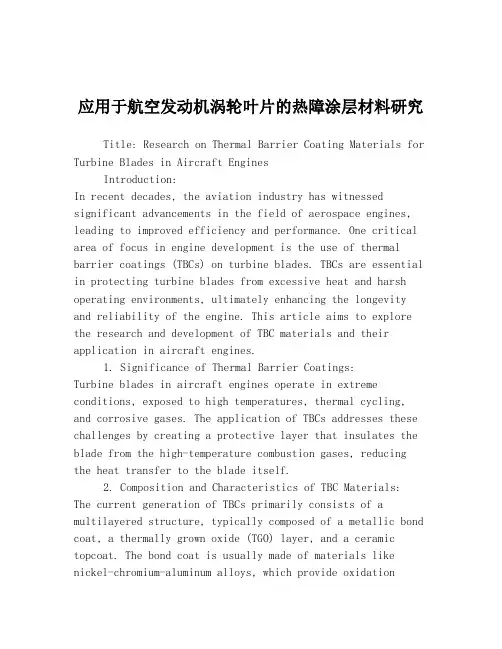
应用于航空发动机涡轮叶片的热障涂层材料研究Title: Research on Thermal Barrier Coating Materials for Turbine Blades in Aircraft EnginesIntroduction:In recent decades, the aviation industry has witnessed significant advancements in the field of aerospace engines, leading to improved efficiency and performance. One critical area of focus in engine development is the use of thermal barrier coatings (TBCs) on turbine blades. TBCs are essential in protecting turbine blades from excessive heat and harsh operating environments, ultimately enhancing the longevity and reliability of the engine. This article aims to explore the research and development of TBC materials and their application in aircraft engines.1. Significance of Thermal Barrier Coatings:Turbine blades in aircraft engines operate in extreme conditions, exposed to high temperatures, thermal cycling, and corrosive gases. The application of TBCs addresses these challenges by creating a protective layer that insulates the blade from the high-temperature combustion gases, reducing the heat transfer to the blade itself.2. Composition and Characteristics of TBC Materials: The current generation of TBCs primarily consists of a multilayered structure, typically composed of a metallic bond coat, a thermally grown oxide (TGO) layer, and a ceramic topcoat. The bond coat is usually made of materials like nickel-chromium-aluminum alloys, which provide oxidationresistance. The TGO layer is formed between the bond coat and the ceramic topcoat, comprising alumina and other oxides. The topcoat, typically yttria-stabilized zirconia (YSZ), is the primary thermal insulator.3. Thermal Resistance Mechanisms:Thermal barrier coatings exhibit thermal resistance through several mechanisms. Firstly, the low thermal conductivity of ceramic materials acts as a barrier to heat transfer. Secondly, the topcoat's strain tolerance and low thermal expansion coefficient prevent cracking caused by thermal cycling. Lastly, the TGO layer acts as a diffusion barrier, preventing the migration of harmful species from the bond coat to the topcoat.4. Challenges in TBC Development:The development of TBC materials faces several challenges. High-temperature corrosion, including hot corrosion and erosion, poses a significant threat to TBC performance. Additionally, the delamination of TBCs due to thermal stresses and interfacial defects requires further attention. Moreover, the limited understanding of TBCs' long-term behavior in service conditions necessitates ongoing research.5. Research on New TBC Materials:Various research efforts have been focused on exploring alternative materials for TBCs. Novel ceramic materials like rare-earth zirconates and hafnia-based oxides show improved thermal and chemical stability compared to YSZ. The use of bond coat modifications, such as diffusion barrier layers and protective overlays, has also been investigated to enhance TBC performance.6. Advanced TBC Manufacturing Techniques:Advancements in manufacturing techniques play a crucial rolein improving TBC performance and reliability. Techniques like electron beam physical vapor deposition (EBPVD) and advanced thermal spray methods offer enhanced coating quality, reduced spallation, and improved strain tolerance. Advanced manufacturing processes are continuously being developed to meet the increasing demands of TBC applications.7. Future Directions and Conclusion:The research and development of TBC materials for aircraft engine turbine blades are essential for the continued advancement of aviation technology. Further research is needed to improve TBC performance under extreme operating conditions, such as high-temperature corrosion and strain tolerance. Exploring emerging materials and manufacturing techniques will undoubtedly contribute to the development of more durable and efficient TBCs.In conclusion, thermal barrier coatings play a crucial role in protecting turbine blades in aircraft engines. Ongoing research efforts are focused on developing new TBC materials and advanced manufacturing techniques to enhance their performance and reliability. Overcoming challenges such as high-temperature corrosion and delamination will ensure continued progress in the aviation industry, leading to higher efficiency, reliability, and safety of aircraft engines.。
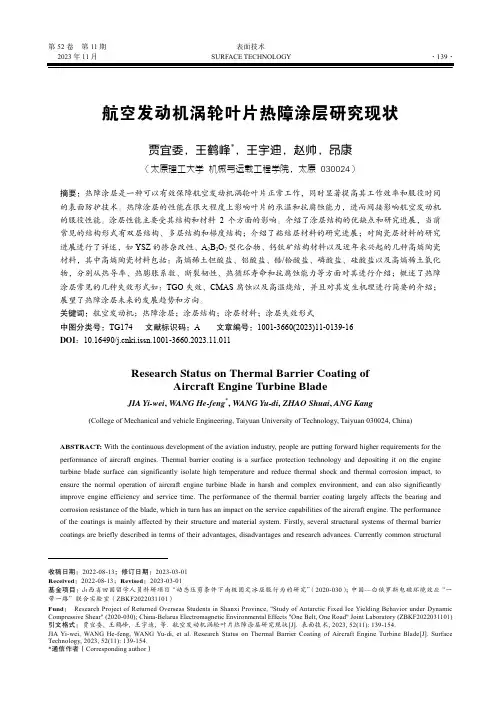
第52卷第11期表面技术2023年11月SURFACE TECHNOLOGY·139·航空发动机涡轮叶片热障涂层研究现状贾宜委,王鹤峰*,王宇迪,赵帅,昂康(太原理工大学 机械与运载工程学院,太原 030024)摘要:热障涂层是一种可以有效保障航空发动机涡轮叶片正常工作,同时显著提高其工作效率和服役时间的表面防护技术。
热障涂层的性能在很大程度上影响叶片的承温和抗腐蚀能力,进而间接影响航空发动机的服役性能。
涂层性能主要受其结构和材料2个方面的影响。
介绍了涂层结构的优缺点和研究进展,当前常见的结构形式有双层结构、多层结构和梯度结构;介绍了粘结层材料的研究进展;对陶瓷层材料的研究进展进行了详述,如YSZ的掺杂改性、A2B2O7型化合物、钙钛矿结构材料以及近年来兴起的几种高熵陶瓷材料,其中高熵陶瓷材料包括:高熵稀土钽酸盐、铝酸盐、锆/铪酸盐、磷酸盐、硅酸盐以及高熵稀土氧化物,分别从热导率、热膨胀系数、断裂韧性、热循环寿命和抗腐蚀能力等方面对其进行介绍;概述了热障涂层常见的几种失效形式如:TGO失效、CMAS腐蚀以及高温烧结,并且对其发生机理进行简要的介绍;展望了热障涂层未来的发展趋势和方向。
关键词:航空发动机;热障涂层;涂层结构;涂层材料;涂层失效形式中图分类号:TG174 文献标识码:A 文章编号:1001-3660(2023)11-0139-16DOI:10.16490/ki.issn.1001-3660.2023.11.011Research Status on Thermal Barrier Coating ofAircraft Engine Turbine BladeJIA Yi-wei, WANG He-feng*, WANG Yu-di, ZHAO Shuai, ANG Kang(College of Mechanical and vehicle Engineering, Taiyuan University of Technology, Taiyuan 030024, China)ABSTRACT: With the continuous development of the aviation industry, people are putting forward higher requirements for the performance of aircraft engines. Thermal barrier coating is a surface protection technology and depositing it on the engine turbine blade surface can significantly isolate high temperature and reduce thermal shock and thermal corrosion impact, to ensure the normal operation of aircraft engine turbine blade in harsh and complex environment, and can also significantly improve engine efficiency and service time. The performance of the thermal barrier coating largely affects the bearing and corrosion resistance of the blade, which in turn has an impact on the service capabilities of the aircraft engine. The performance of the coatings is mainly affected by their structure and material system. Firstly, several structural systems of thermal barrier coatings are briefly described in terms of their advantages, disadvantages and research advances. Currently common structural收稿日期:2022-08-13;修订日期:2023-03-01Received:2022-08-13;Revised:2023-03-01基金项目:山西省回国留学人员科研项目“动态压剪条件下南极固定冰屈服行为的研究”(2020-030);中国—白俄罗斯电磁环境效应“一带一路”联合实验室(ZBKF2022031101)Fund:Research Project of Returned Overseas Students in Shanxi Province, "Study of Antarctic Fixed Ice Yielding Behavior under Dynamic Compressive Shear" (2020-030); China-Belarus Electromagnetic Environmental Effects "One Belt, One Road" Joint Laboratory (ZBKF2022031101)引文格式:贾宜委, 王鹤峰, 王宇迪, 等. 航空发动机涡轮叶片热障涂层研究现状[J]. 表面技术, 2023, 52(11): 139-154.JIA Yi-wei, WANG He-feng, WANG Yu-di, et al. Research Status on Thermal Barrier Coating of Aircraft Engine Turbine Blade[J]. Surface Technology, 2023, 52(11): 139-154.*通信作者(Corresponding author)·140·表面技术 2023年11月forms include: double-layer structures, multi-layer structures and gradient structures. The classical double-layer structure is still most widely used. The preparation process of multi-layer and gradient structures is more complex and both multi-layer and dual ceramic layer structures are prone to interfacial bonding problems in use, which limits their widespread application. Secondly, the current research status of binder layer materials for thermal barrier coatings is summarized. The current research on MCrAlY alloy and NiAl alloy mainly focuses on the modification of doping elements and MCrAlY alloy still needs to be improved in terms of interfacial bonding and high temperature oxidation resistance, while the advantage of NiAl alloy mainly lies in its creep resistance and oxidation resistance, which can be used as a more ideal binder layer material after modification. At the same time, the research progress of several ceramic layer materials is introduced, such as the doping modification of YSZ, A2B2O7-type compounds, chalcogenide structural materials and several high-entropy ceramic materials that have emerged in recent years. The high-entropy ceramic materials mainly include: high-entropy rare-earth tantalates, high-entropy rare-earth aluminates, high-entropy rare-earth zirconates/hafniumates, high-entropy rare-earth phosphates, high-entropy rare-earth silicates and high-entropy rare-earth oxides, in terms of thermophysical attributes such as thermal cycle life and CTE. Currently, among the doping modifications of YSZ, multi-oxide doping provides more comprehensive performance enhancement. Doping modifications of A2B2O7-type compounds have also yielded good results, but the strength and fracture toughness of the materials need further improvement. Among the high-entropy ceramic materials, high-entropy rare-earth zirconates and high-entropy rare-earth oxides are highly promising materials for ceramic layers. In order to meet the increasing requirements for engine performance, the improvement of the performance of thermal barrier coatings still needs to be continuously explored.Common forms of failure of thermal barrier coatings, such as TGO failure, CMAS corrosion, salt spray corrosion and high temperature sintering, are reviewed and the mechanisms by which they occur are briefly described. Finally, future trends and directions for thermal barrier coatings are presented. In future research, attention should be paid to improving the mechanical properties of coatings, as well as to investigating the mechanisms behind changes in coating performance, and to achieving more accurate predictions of coating life based on current research.KEY WORDS: aircraft engines; thermal barrier coatings; coating structures; coating materials; coating failure forms随着我国航空工业的不断进步,人们对飞行器服役性能等方面的要求在逐渐提高。
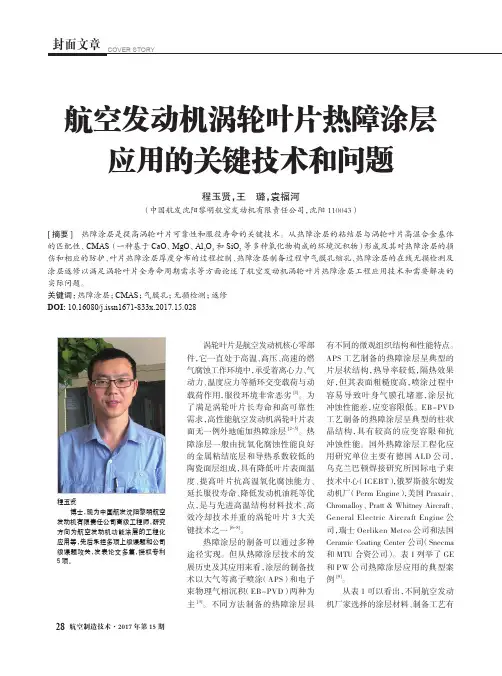
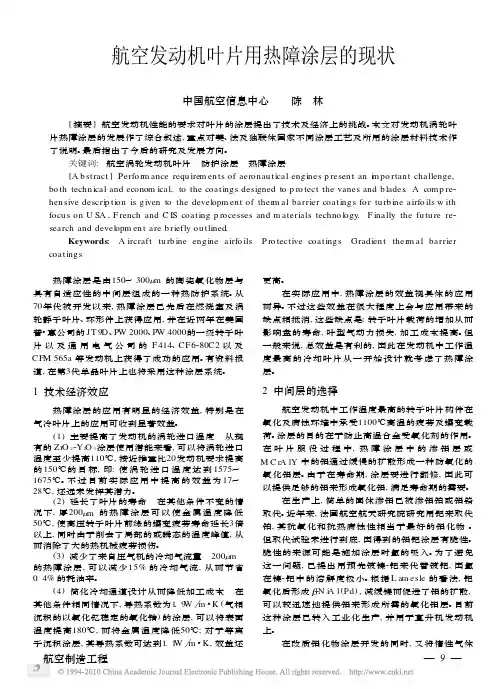
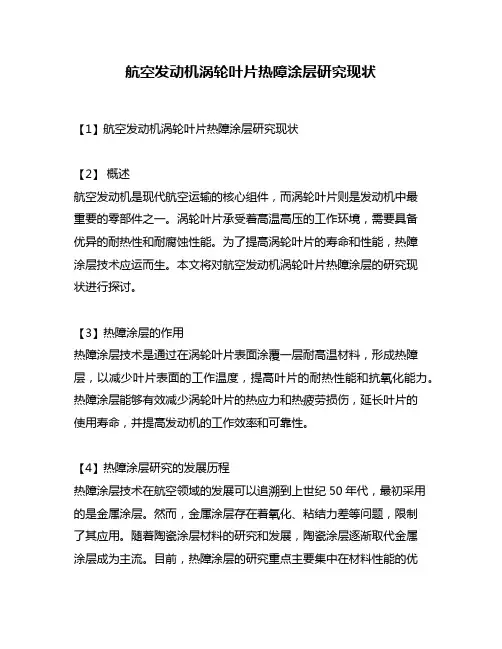
航空发动机涡轮叶片热障涂层研究现状【1】航空发动机涡轮叶片热障涂层研究现状【2】概述航空发动机是现代航空运输的核心组件,而涡轮叶片则是发动机中最重要的零部件之一。
涡轮叶片承受着高温高压的工作环境,需要具备优异的耐热性和耐腐蚀性能。
为了提高涡轮叶片的寿命和性能,热障涂层技术应运而生。
本文将对航空发动机涡轮叶片热障涂层的研究现状进行探讨。
【3】热障涂层的作用热障涂层技术是通过在涡轮叶片表面涂覆一层耐高温材料,形成热障层,以减少叶片表面的工作温度,提高叶片的耐热性能和抗氧化能力。
热障涂层能够有效减少涡轮叶片的热应力和热疲劳损伤,延长叶片的使用寿命,并提高发动机的工作效率和可靠性。
【4】热障涂层研究的发展历程热障涂层技术在航空领域的发展可以追溯到上世纪50年代,最初采用的是金属涂层。
然而,金属涂层存在着氧化、粘结力差等问题,限制了其应用。
随着陶瓷涂层材料的研究和发展,陶瓷涂层逐渐取代金属涂层成为主流。
目前,热障涂层的研究重点主要集中在材料性能的优化、工艺改进以及涂层与基底材料之间的耦合问题等方面。
【5】热障涂层材料的选择航空发动机涡轮叶片的热障涂层材料需要具备优异的耐高温性能、热膨胀系数匹配性和抗氧化能力。
目前常用的涂层材料主要有氧化铝、氧化锆和复合材料等。
不同的涂层材料具有各自的特点和优势,在应用中需要根据具体的工作环境和性能要求来选择合适的材料。
【6】研究热障涂层的关键技术热障涂层的研究涉及到材料制备、涂层工艺、热处理和性能评价等多个方面。
其中,材料制备的关键技术包括热喷涂和物理气相沉积等方法,涂层工艺的关键技术包括预处理、喷涂参数控制和后处理等。
涂层与基底材料之间的耦合问题也是热障涂层研究中的一个重要方向。
【7】热障涂层的性能评价热障涂层的性能评价主要包括热稳定性、热膨胀性、抗氧化性和机械性能等指标。
常用的测试方法有热循环试验、热膨胀系数测试、高温氧化试验和机械性能测试等。
通过对涂层性能的评价,可以为进一步改进和优化涂层设计提供参考和依据。
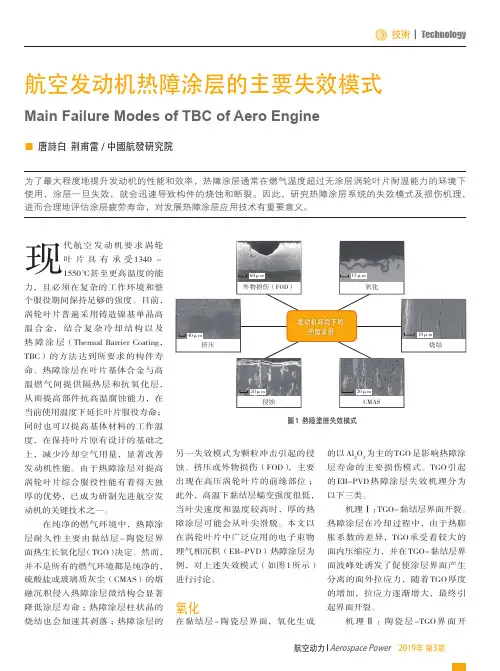
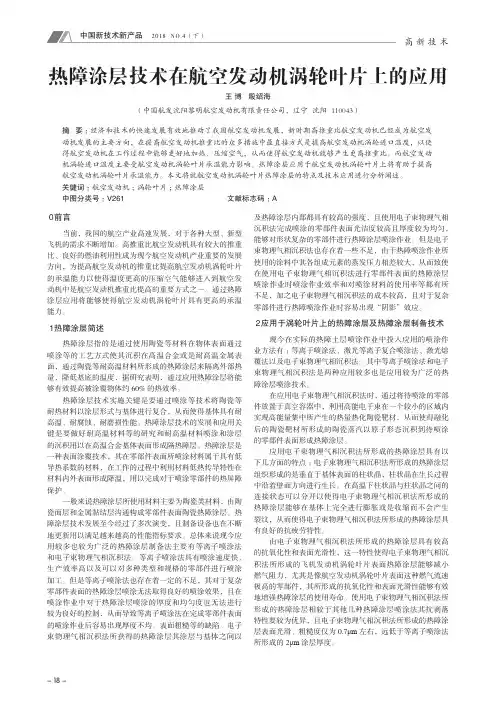
- 18 -高 新 技 术0 前言当前,我国的航空产业高速发展,对于各种大型、新型飞机的需求不断增加。
高推重比航空发动机具有较大的推重比、良好的燃油利用性成为现今航空发动机产业重要的发展方向,为提高航空发动机的推重比提高航空发动机涡轮叶片的承温能力以使得温度更高的压缩空气能够进入到航空发动机中是航空发动机推重比提高的重要方式之一。
通过热障涂层应用将能够使得航空发动机涡轮叶片具有更高的承温能力。
1 热障涂层简述热障涂层指的是通过使用陶瓷等材料在物体表面通过喷涂等的工艺方式使其沉积在高温合金或是耐高温金属表面,通过陶瓷等耐高温材料所形成的热障涂层来隔离外部热量,降低基底的温度,据研究表明,通过应用热障涂层将能够有效提高被涂覆物体约60%的热效率。
热障涂层技术实施关键是要通过喷涂等技术将陶瓷等耐热材料以涂层形式与基体进行复合,从而使得基体具有耐高温、耐腐蚀、耐磨损性能。
热障涂层技术的发展和应用关键是要做好耐高温材料等的研究和耐高温材料喷涂和涂层的沉积用以在高温合金基体表面形成隔热障层。
热障涂层是一种表面涂覆技术,其在零部件表面所喷涂材料属于具有低导热系数的材料,在工作的过程中利用材料低热传导特性在材料内外表面形成降温,用以完成对于喷涂零部件的热屏障保护。
一般来说热障涂层所使用材料主要为陶瓷类材料,由陶瓷面层和金属黏结层沟通构成零部件表面陶瓷热障涂层。
热障涂层技术发展至今经过了多次演变,且制备设备也在不断地更新用以满足越来越高的性能指标要求。
总体来说现今应用较多也较为广泛的热障涂层制备法主要有等离子喷涂法和电子束物理气相沉积法。
等离子喷涂法具有喷涂速度快、生产效率高以及可以对多种类型和规格的零部件进行喷涂加工。
但是等离子喷涂法也存在着一定的不足,其对于复杂零部件表面的热障涂层喷涂无法取得良好的喷涂效果,且在喷涂作业中对于热障涂层喷涂的厚度和均匀度也无法进行较为良好的控制,从而导致等离子喷涂法在完成零部件表面的喷涂作业后容易出现厚度不均、表面粗糙等的缺陷。


涂层技术在航空发动机中的应用(一)涂层技术在航空发动机中的应用1. 提高发动机效率•热障涂层(TBC)热障涂层是一种高温耐受能力极强的陶瓷涂层,在航空发动机中有广泛应用。
它可以有效降低高温燃烧室和涡轮内部的表面温度,减少热量传递到其他部件,提高燃烧效率和涡轮的使用寿命。
热障涂层采用涂敷的方式施加在发动机部件表面,形成一层隔热层,同时具备优异的耐热性、耐腐蚀性和耐磨性。
•摩擦涂层摩擦涂层是一种能够减少摩擦阻力、降低能耗和延长机械部件寿命的涂层技术。
在航空发动机中,喷涂摩擦涂层可以应用于涡轮叶片表面以减少摩擦热造成的能量损耗,提高发动机效率。
该涂层通常由涂料和固化剂组成,喷涂后会形成一层耐磨、耐热的涂层,提供涡轮叶片所需的低摩擦系数。
2. 保护发动机结构•防腐蚀涂层发动机作为飞机的核心部件,其表面容易受到腐蚀的影响。
防腐蚀涂层能够降低发动机金属部件受到酸性气体、高温、湿度等因素的腐蚀程度,提高其耐久性。
航空发动机中使用的防腐蚀涂层通常采用环氧树脂和特殊添加剂,能够有效隔离金属与外界环境,降低腐蚀速度,同时具备耐温性能。
•降噪涂层航空发动机产生的噪音是对航空乘客和地面居民造成的主要干扰。
降噪涂层是一种能够减少发动机噪音输出的技术。
该涂层通常由吸声材料和表面粗糙度调整剂构成,能够通过吸收噪音和改变噪音传播路径来降低发动机产生的噪音水平。
降噪涂层的应用可以有效改善乘客舒适度,减少航空噪声对环境的影响。
3. 增强结构强度•硬质涂层硬质涂层是一种附着在金属表面的高硬度涂层,可以提供结构件的抗磨损和抗腐蚀能力。
在航空发动机中,硬质涂层通常应用于涡轮轴承、气门、活塞等部件表面,能够减少零部件间的摩擦和磨损,提高结构件的使用寿命。
常见的硬质涂层材料包括碳化硅、氮化硼等。
•纳米涂层纳米涂层是一种厚度在纳米级别的超薄涂层,它能够提供出色的防腐蚀和防磨损性能。
航空发动机中的纳米涂层可应用于活塞环、气缸内壁等部件表面,能够减少部件摩擦和磨损,提高结构件的使用寿命。
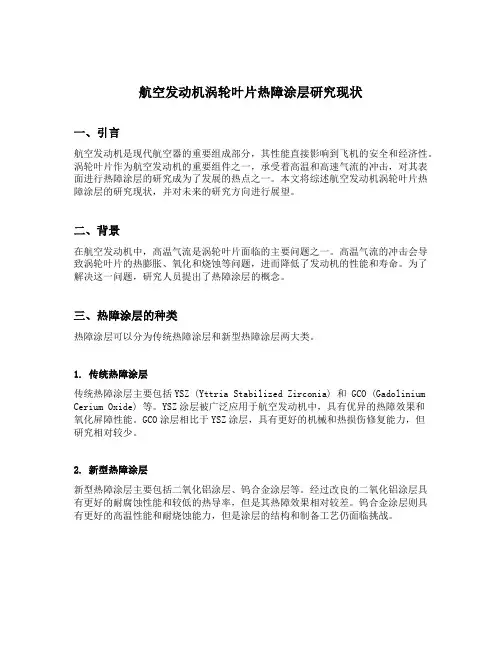
航空发动机涡轮叶片热障涂层研究现状一、引言航空发动机是现代航空器的重要组成部分,其性能直接影响到飞机的安全和经济性。
涡轮叶片作为航空发动机的重要组件之一,承受着高温和高速气流的冲击,对其表面进行热障涂层的研究成为了发展的热点之一。
本文将综述航空发动机涡轮叶片热障涂层的研究现状,并对未来的研究方向进行展望。
二、背景在航空发动机中,高温气流是涡轮叶片面临的主要问题之一。
高温气流的冲击会导致涡轮叶片的热膨胀、氧化和烧蚀等问题,进而降低了发动机的性能和寿命。
为了解决这一问题,研究人员提出了热障涂层的概念。
三、热障涂层的种类热障涂层可以分为传统热障涂层和新型热障涂层两大类。
1. 传统热障涂层传统热障涂层主要包括YSZ (Yttria Stabilized Zirconia) 和 GCO (Gadolinium Cerium Oxide) 等。
YSZ涂层被广泛应用于航空发动机中,具有优异的热障效果和氧化屏障性能。
GCO涂层相比于YSZ涂层,具有更好的机械和热损伤修复能力,但研究相对较少。
2. 新型热障涂层新型热障涂层主要包括二氧化铝涂层、钨合金涂层等。
经过改良的二氧化铝涂层具有更好的耐腐蚀性能和较低的热导率,但是其热障效果相对较差。
钨合金涂层则具有更好的高温性能和耐烧蚀能力,但是涂层的结构和制备工艺仍面临挑战。
四、热障涂层的制备工艺热障涂层的制备工艺对涂层性能的影响至关重要。
目前,常见的热障涂层制备工艺包括物理气相沉积(Physical Vapor Deposition,PVD)、化学气相沉积(Chemical Vapor Deposition,CVD)和高速火焰喷涂(High VelocityOxygen/Fuel,HVOF)等。
1. PVDPVD技术通过物理手段将材料从固态直接转变为气态,然后沉积到基底上。
PVD制备的热障涂层具有致密的结构、低孔隙率和较高的结合强度,但是制备成本较高。
2. CVDCVD技术是利用化学反应将气态前驱体沉积在基底上,形成热障涂层。
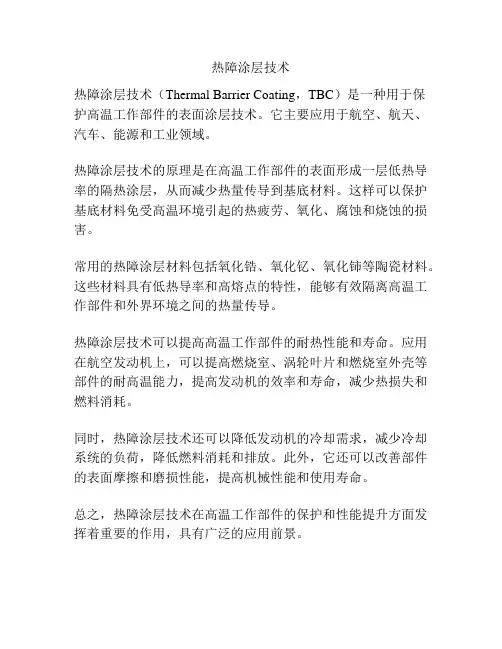
热障涂层技术
热障涂层技术(Thermal Barrier Coating,TBC)是一种用于保
护高温工作部件的表面涂层技术。
它主要应用于航空、航天、汽车、能源和工业领域。
热障涂层技术的原理是在高温工作部件的表面形成一层低热导率的隔热涂层,从而减少热量传导到基底材料。
这样可以保护基底材料免受高温环境引起的热疲劳、氧化、腐蚀和烧蚀的损害。
常用的热障涂层材料包括氧化锆、氧化钇、氧化铈等陶瓷材料。
这些材料具有低热导率和高熔点的特性,能够有效隔离高温工作部件和外界环境之间的热量传导。
热障涂层技术可以提高高温工作部件的耐热性能和寿命。
应用在航空发动机上,可以提高燃烧室、涡轮叶片和燃烧室外壳等部件的耐高温能力,提高发动机的效率和寿命,减少热损失和燃料消耗。
同时,热障涂层技术还可以降低发动机的冷却需求,减少冷却系统的负荷,降低燃料消耗和排放。
此外,它还可以改善部件的表面摩擦和磨损性能,提高机械性能和使用寿命。
总之,热障涂层技术在高温工作部件的保护和性能提升方面发挥着重要的作用,具有广泛的应用前景。
航空发动机涂层技术研究随着航空事业的不断发展,航空发动机的性能要求也不断提高。
而航空发动机受到高温、高压、高速等极端条件的影响,需要拥有更高的耐久性和抗腐蚀能力。
因此,发动机涂层技术得到了广泛的研究和应用。
一、发动机涂层技术的发展历程发动机涂层技术最初应用于喷气发动机的涡轮叶片表面。
20世纪60年代,涡轮叶片表面喷涂金属材料的方法被广泛应用。
20世纪70年代,高速航空发动机的涂层技术开始使用陶瓷涂层,提高了航空发动机的稳定性和可靠性。
二、航空发动机涂层技术的分类1. 热障涂层:在航空发动机叶片表面涂覆热障涂层,可以有效降低高温下的材料熔融和氧化。
常用的热障涂层材料有Y2O3、ZrO2等。
2. 抗磨涂层:航空发动机需要耐高温、耐腐蚀、耐磨损,抗磨涂层是其中的一种。
其可以降低机件间的摩擦,减少磨损,提高机件的使用寿命。
3. 抗氧化涂层:航空发动机在高温下会发生氧化,导致表面的金属材料丧失其原有性能。
抗氧化涂层的应用可以有效提高发动机的抗氧化能力。
4. 先进材料涂层:随着材料科学技术的发展,航空发动机涂层材料也得到了不断的升级。
某些先进材料涂层如TiAlN、CrN等,具有极高的耐腐蚀性能、高的硬度和低的摩擦系数等特点,可以提高发动机的性能。
三、航空发动机涂层技术的应用1. 提高发动机性能:航空发动机涂层技术的应用可以有效提高发动机的综合性能。
例如,热障涂层可以降低高温下的材料熔融和氧化,提高发动机在高温环境下的可靠性。
2. 延长发动机使用寿命:航空发动机在使用过程中容易受到高温、高压、高速等极端条件的影响,导致金属材料发生氧化或熔化。
而涂层技术可以有效延长发动机的使用寿命,提高发动机的可靠性和耐用性。
3. 降低发动机维护成本:航空发动机的维护成本很高,但涂层技术的应用可以有效降低发动机的维护成本。
例如,抗氧化涂层可以降低发动机在高温下的氧化程度,延长金属材料的使用寿命,减少维护工作的频次和费用。
四、航空发动机涂层技术的未来发展随着航空事业的不断发展,航空发动机性能的提高要求也不断增加。
航空发动机作为现代航空航天领域的核心动力装置,其性能的优劣直接关系到飞行器的飞行效率、可靠性和安全性。
而在航空发动机的众多关键部件中,涡轮叶片起着至关重要的作用。
涡轮叶片在高温、高压、高速的恶劣工作环境下运行,承受着巨大的热负荷和机械负荷,因此对其进行有效的防护和隔热至关重要。
热障涂层作为一种有效的防护手段,近年来在航空发动机涡轮叶片领域得到了广泛的研究和应用。
热障涂层的概念最早可以追溯到上世纪五六十年代,当时主要应用于火箭发动机的燃烧室部件。
随着航空技术的不断发展,热障涂层逐渐被引入到航空发动机涡轮叶片上,以提高其耐高温性能和使用寿命。
经过多年的发展,热障涂层技术已经取得了显著的进步,并且在不断地完善和创新。
一、热障涂层的工作原理和性能要求热障涂层的主要作用是降低涡轮叶片表面的温度,从而保护叶片免受高温的损害。
其工作原理是通过在涡轮叶片表面形成一层具有低热导率的涂层,阻挡热量向叶片内部的传导,同时阻止叶片表面的热量向外辐射,从而达到隔热的效果。
热障涂层通常由陶瓷层和金属粘结层组成,陶瓷层具有较高的熔点和低热导率,能够承受高温环境;金属粘结层则起到连接陶瓷层和叶片基体的作用,并且具有良好的高温稳定性和抗氧化性。
热障涂层的性能要求非常严格,主要包括以下几个方面:1. 良好的耐高温性能:能够在航空发动机工作的高温环境下长期稳定运行,不发生熔化、分解或剥落等现象。
2. 较低的热导率:有效地降低叶片表面的温度,提高叶片的热效率。
3. 良好的热稳定性:在温度变化和热循环过程中,涂层不发生开裂、剥落或变形等问题。
4. 良好的抗氧化性和抗腐蚀性能:能够抵抗发动机燃烧气体中的氧化和腐蚀作用,延长涂层的使用寿命。
5. 与叶片基体良好的结合力:确保涂层在长期的工作过程中不脱落。
6. 较低的热膨胀系数:与叶片基体的热膨胀系数相匹配,减少因热应力引起的涂层开裂和剥落。
二、热障涂层的制备方法目前,常用的热障涂层制备方法主要有等离子喷涂、电弧喷涂、火焰喷涂、物理气相沉积(PVD)和化学气相沉积(CVD)等。
航空发动机涡轮叶片热障涂层研究现状一、引言航空发动机是现代航空的核心部件,其性能的优劣直接影响着飞行器的飞行效率和安全性。
而航空发动机涡轮叶片是发动机中最重要的部分之一,其工作环境极其恶劣,需要承受高温高压等极端条件。
为了保证涡轮叶片的寿命和可靠性,热障涂层技术被广泛应用于航空发动机涡轮叶片上。
二、热障涂层的概念和分类热障涂层(Thermal Barrier Coatings, TBC)是一种能够提供保护和绝缘作用的表面覆盖层,在高温环境下能够有效地减少受到热应力和氧化腐蚀等因素的影响。
根据不同的制备方法和材料组成,热障涂层可以分为多种类型,如YSZ(氧化锆稳定化)陶瓷涂层、MCrAlY(M 表示金属元素,Cr表示铬元素,Al表示铝元素,Y表示钇元素)金属涂层、La2Zr2O7(氧化镧锆)涂层等。
三、热障涂层的应用热障涂层技术已经广泛应用于航空发动机涡轮叶片上,主要是为了提高叶片的耐高温性能和抗氧化腐蚀性能。
热障涂层可以有效地减少叶片表面温度,降低热应力,延长叶片寿命。
同时,热障涂层还可以提供绝缘作用,防止热量传递到叶片内部,从而保护叶片的材料性能。
四、热障涂层的制备方法和材料选择制备方法包括物理气相沉积法、化学气相沉积法、电弧等离子喷涂法、等离子体喷涂法等。
不同的制备方法有着各自的优缺点,在选择时需要考虑到生产效率、成本、质量等因素。
材料选择方面需要考虑到其耐高温性能、导热系数、化学稳定性等因素。
五、发展趋势未来航空发动机对于热障涂层技术的需求将会更加迫切,同时也面临着更高的要求。
未来热障涂层需要具备更高的耐高温性能、更低的导热系数、更好的耐氧化腐蚀性能等特点。
此外,热障涂层还需要具备可持续性和环保性,在制备过程中减少对环境的影响。
六、结论航空发动机涡轮叶片热障涂层技术是目前航空领域中不可或缺的一部分。
通过选择合适的制备方法和材料,可以有效地提高叶片的耐高温性能和抗氧化腐蚀性能,延长其使用寿命。
航空发动机涡轮叶片热障涂层研究现状再探讨航空发动机涡轮叶片热障涂层研究现状再探讨导言:航空发动机的性能和可靠性对飞机的运行至关重要。
在发动机的高温工作环境下,涡轮叶片是承受最高温度和压力的部件。
为了保护涡轮叶片不受高温环境的损害,热障涂层技术应运而生。
本文将对航空发动机涡轮叶片热障涂层的研究现状进行深入的探讨,并提供自己的观点和理解。
1. 热障涂层的概念和作用热障涂层是一层应用于涡轮叶片表面的陶瓷涂层,其主要作用是减少涡轮叶片的工作温度,防止高温热量对涡轮叶片的热疲劳和氧化损伤。
热障涂层的微孔结构可以形成隔热层,将热量和气体分离,有效降低涡轮叶片的工作温度。
2. 热障涂层的组成和制备方法热障涂层通常由两层构成:粘结层和陶瓷层。
粘结层用于将涂层牢固地附着在涡轮叶片表面,而陶瓷层则是实际起到隔热作用的层次。
常用的制备方法包括物理气相沉积(Physical Vapor Deposition,PVD)、化学气相沉积(Chemical Vapor Deposition,CVD)和等离子喷涂(Plasma Spraying)。
不同的制备方法有着不同的特点和应用范围。
3. 热障涂层的工作原理和性能评估热障涂层的工作原理主要有热障效应、潜热效应和氧化膜效应。
热障效应通过减缓热量传递来降低涡轮叶片的工作温度,而潜热效应则通过蒸发水分吸收热量来进一步降温。
氧化膜效应则是指陶瓷层表面形成的氧化膜可以起到一定的隔热作用。
热障涂层的性能评估可通过材料的热导率、热膨胀系数、气孔率等参数来衡量。
此外,热障涂层的附着力、抗剥离性和耐热性也是评估其性能的重要指标。
4. 热障涂层的改进和应用展望当前,热障涂层的改进主要集中在提高隔热性能、增强涂层的附着力和耐腐蚀性。
新型材料的研究和开发,如陶瓷复合涂层和导热性较低的材料,有望在提高热障涂层性能方面发挥重要作用。
此外,随着航空发动机工作温度的进一步提高,热障涂层技术也需要不断创新和改进。
先进航空发动机纳米结构热障涂层关键技术及其规模化应用随着航空工业的发展,对于航空发动机的效率和性能要求越来越高。
而热障涂层作为航空发动机中关键的组成部分之一,其性能的提升对于发动机整体性能的提升具有至关重要的意义。
纳米结构热障涂层作为一种新型的热障涂层,具有较高的导热阻尼和导热材料性能,能够有效地降低发动机工作温度,提高燃烧效率,并减少了机械磨损和热疲劳。
纳米结构热障涂层的制备技术是实现其规模化应用的关键之一。
当前,热喷涂法、溅射法和离子束溅射等方法是制备纳米结构热障涂层的常用技术。
其中,热喷涂法是最为常用的一种,通过高温高速喷涂,使涂层颗粒熔化并快速冷却形成一种具有纳米级颗粒的多层热障涂层。
溅射法则是通过将基底材料蒸发成离子,并沉积到基底表面的方法,形成纳米级结构的热障涂层。
离子束溅射则是一种将金属基底材料离子化并喷射到基底表面的方法,能够制备纳米级颗粒的热障涂层。
纳米结构热障涂层的主要材料是氧化锆、氧化钇等化合物和元素,其制备过程中需要进行多种工艺的优化。
首先是材料的纯度和密度,高纯度和致密度的材料可以提高涂层的抗热膨胀性能和导热性能。
其次是涂层的结构和扩散行为,通过控制喷射粒子的能量和温度,可以制备出不同的纳米结构,从而调控热障涂层的热传导和机械性能。
再次是涂层的粘结强度和抗剥落性能,通过优化喷涂工艺、纳米材料的合成过程以及热处理工艺,可以提高涂层与金属基底的结合强度和抗剥落性。
最后是涂层的稳定性和耐热性能,通过合理的材料设计和结构调控,可以提高涂层的抗氧化、抗热疲劳和耐腐蚀性能。
纳米结构热障涂层的规模化应用主要涉及到涂层的制备工艺、设备和材料的优化。
首先是涂层制备工艺的自动化控制,通过引入机器人和自动化设备,可以实现涂层制备的高效和稳定。
其次是涂层制备设备的优化,例如,采用多喷涂头、高速喷涂和高能量喷涂等技术,可以提高喷涂速度和涂层质量,从而降低生产成本。
最后是涂层材料的优化,通过合成新型材料和调控材料成分,可以提高涂层的性能和稳定性。